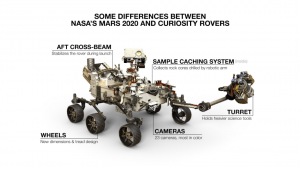NASA plans to launch a rover to Mars this July to hunt for signs of ancient Red Planet life.
The new Mars 2020 rover’s body is similar to that of the older Curiosity rover, which landed in 2012. But the two machines are quite different in important ways.
Curiosity’s mission centers on assessing the past habitability of its landing site, the 96-mile-wide (154 kilometers) Gale Crater. The rover quickly determined that Gale harbored a potentially habitable lake-and-stream system in the ancient past, and Curiosity is now fleshing out that long-gone environment as it climbs the foothills of Mount Sharp, which rises 3.4 miles (5.5 km) into the sky from Gale’s center.

Mars 2020 will characterize the habitability of its landing site, Jezero Crater, after touching down in February 2021. But the new rover will also hunt for ancient biosignatures — signs of past life that could be lurking in rock or soil samples. And Mars 2020 will cache the most promising samples for return to Earth by a future mission.
Read more: space
Ask me anything
Explore related questions





